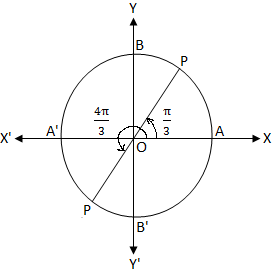Subscribe to our ▶️ YouTube channel 🔴 for the latest videos, updates, and tips.
tan x - √3 = 0
We will discuss about the general solution of the equation tan x minus square root of 3 equals 0 (i.e., tan x - √3 = 0) or tan x equals square root of 3 (i.e., tan x = √3).
How to find the general solution of the trigonometric equation tan x = √3 or tan x - √3 = 0?
Solution:
We have,
tan x - √3 = 0
⇒ tan x = √3
⇒ tan x = \(\frac{π}{3}\)
Again, tan x = √3
⇒ tan x = \(\frac{π}{3}\)
⇒ tan x = (π + \(\frac{π}{3}\))
⇒ tan x = tan \(\frac{4π}{3}\)
Let O be the centre of a unit circle. We know that in unit
circle, the length of the circumference is 2π.
If we started from A and moves in anticlockwise direction then at the points A, B, A', B' and A, the arc length travelled are 0, \(\frac{π}{2}\), π, \(\frac{3π}{2}\), and 2π.
Therefore, from the above unit circle it is clear that the final arm OP of the angle θ lies either in the first or in the final third quadrant.
If the final arm OP lies the first quadrant then,
tan x = √3
⇒ tan x = cos \(\frac{π}{3}\)
⇒ tan x = ten (2nπ + \(\frac{π}{3}\)), Where n ∈ I (i.e., n = 0, ± 1, ± 2, ± 3,…….)
Therefore, x = 2nπ + \(\frac{π}{3}\) …………….. (i)
Again, the final arm OP lies in the third quadrant then,
tan x = √3
⇒ tan x = cos \(\frac{4π}{3}\)
⇒ tan x = ten (2nπ + \(\frac{4π}{3}\)) , Where n ∈ I (i.e., n = 0, ± 1, ± 2, ± 3,…….)
Therefore, x = 2nπ + \(\frac{π}{3}\) …………….. (ii)
Therefore, the general solution of equation tan x - √3 = 0 are the infinite sets of values of x given in (i) and (ii).
Hence general solution of tan x - √3 = 0 is x = nπ + \(\frac{π}{3}\), n ∈ I.
- General solution of the equation sin x = ½
- General solution of the equation cos x = 1/√2
- General solution of the equation tan x = √3
- General Solution of the Equation sin θ = 0
- General Solution of the Equation cos θ = 0
- General Solution of the Equation tan θ = 0
- General Solution of the Equation sin θ = sin ∝
- General Solution of the Equation sin θ = 1
- General Solution of the Equation sin θ = -1
- General Solution of the Equation cos θ = cos ∝
- General Solution of the Equation cos θ = 1
- General Solution of the Equation cos θ = -1
- General Solution of the Equation tan θ = tan ∝
- General Solution of a cos θ + b sin θ = c
- Trigonometric Equation Formula
- Trigonometric Equation using Formula
- General solution of Trigonometric Equation
- Problems on Trigonometric Equation
11 and 12 Grade Math
From tan x - √3 = 0 to HOME PAGE
Didn't find what you were looking for? Or want to know more information about Math Only Math. Use this Google Search to find what you need.



New! Comments
Have your say about what you just read! Leave me a comment in the box below. Ask a Question or Answer a Question.